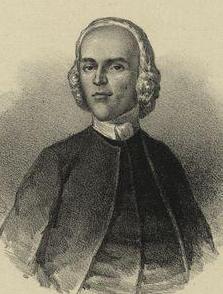William Henry (1729)
| This article needs additional genealogical research. One or more relatives can be traced. Please help improve this article by researching relatives. |
To do: Parents are traceable... To do: There's a TON of info about William on this page
| William Henry | |
|---|---|
 | |
| Born |
May 19, 1729[1] Downingtown, Chester, Pennsylvania[2] |
| Died | December 15, 1786 (aged 57)[3] |
| Resting place | Moravian Cemetery, Lititz, Lancaster County, Pennsylvania[4] |
| Spouse | Ann Woods (m. 1765) in Lancaster, Pennsylvania[5] |
| Children | George Henry (1760)[6] and 12 other children[7] |
| Parents |
John Henry (1700 – 1747) Elizabeth De Vinney (1701 – 1778)[8] |
Continental Congressman, Businessman, Inventor. He followed his father into gunsmithing and gun manufacturing. He was Justice of the Lancaster County Court of Common Pleas in 1770, 1773, and 1777. In 1771 he was appointed as a State Canal Commissioner, served in the State Assembly in 1776, and in 1777 he was appointed to the State Council of Safety. At the start of the Revolution he was commissioned Assistant Commissary General with the rank of Colonel. From 1777 to 1785 Henry was Lancaster County Treasurer and in 1780 he was appointed Presiding Judge of the Court of Common Pleas. From 1784 to 1785 he was a member of the Continental Congress. Henry was a skilled metal worker and machinist and invented the screw auger, a tool with threads, a sharp point and cutting edges used for boring holes in hard materials. Having learned of James Watt's invention of the steam engine, Henry made one and attempted to use it to propel a boat. He died before he could perfect this concept, but his work inspired others, including Robert Fulton. The Henry gun business produced the firearm known as the Pennsylvania or Kentucky rifle. The company continued into the 19th Century, producing weapons for the Revolution and the War of 1812, with Henry rifles used by settlers throughout the western United States because of their reliability and low cost. Henry was originally interred in Moravian Cemetery and later reburied in Greenwood. (bio by: Bill McKern)[9]
- More information available on actual wikipedia entry.
- A memorial stone to William was erected in the Greenwood Cemetery in Lancaster, Pennsylvania.[10]
To do -- Integrate other sources:
- Robert H. Thurston, Makers of America: Robert Fulton His Life its Results. Dodd, Mead, and Company Publishers: New York, 1891
- He was commissioned justice of the peace, in 1758, 1770, and 1777[11]
- Associate justice of the common pleas, quarter sessions and orphans' court, November 18, 1780[12]
- In 1776 he was elected a member of the Assembly, and from October 17 to December 4, 1777, served in the Council of Safety of Pennsylvania, and as county treasurer from 1777 to his death
- His appointment as armourer of the State is dated September 4, 1778
- he was selected one of the commissioners to limit prices of merchandise, in the convention called by meeting at Hartford, Connecticut, October 29, 1779, to assemble at Philadelphia, January 5, 1780
- He was also appointed dedimus potestatem in 1778, and 1781.
- As assistant commissary general in 1778 he was of great service to the army in the field.
- He served two terms in the Old Congress, 1784-1785.
- In 1767 he was elected a member of hte American Philosophical Society, was one of the first members of the Society for Promoting Agriculture, and a founder of the Juliana Library of Lancaster.
- As an ingenious inventor he enjoyed a high reputation, particularly in the application of steam for motive power, and in 1771 he invented the screw-auger.
Notes
- ↑ http://trees.ancestry.com/tree/1717034/person/-821256418
- ↑ http://trees.ancestry.com/tree/1717034/person/-821256418
- ↑ http://trees.ancestry.com/tree/1717034/person/-821256418
- ↑ http://familytreemaker.genealogy.com/users/h/a/r/Richard-Allen-Harper/GENE7-0004.html
- ↑ http://trees.ancestry.com/tree/1717034/person/-821256418
- ↑ http://trees.ancestry.com/tree/1717034/person/-821256418
- ↑ http://en.wikipedia.org/wiki/Ann_Wood_Henry
- ↑ http://trees.ancestry.com/tree/1717034/person/-821256418
- ↑ http://www.findagrave.com/cgi-bin/fg.cgi?page=gr&GSln=henry&GSfn=william&GSbyrel=in&GSdyrel=in&GSst=40&GScnty=2276&GScntry=4&GSob=n&GRid=19445946&df=all&
- ↑ http://www.findagrave.com/cgi-bin/fg.cgi?page=gr&GSln=henry&GSfn=william&GSbyrel=in&GSdyrel=in&GSst=40&GScnty=2276&GScntry=4&GSob=n&GRid=19445946&df=all&
- ↑ http://familytreemaker.genealogy.com/users/h/a/r/Richard-Allen-Harper/GENE7-0004.html
- ↑ http://familytreemaker.genealogy.com/users/h/a/r/Richard-Allen-Harper/GENE7-0004.html